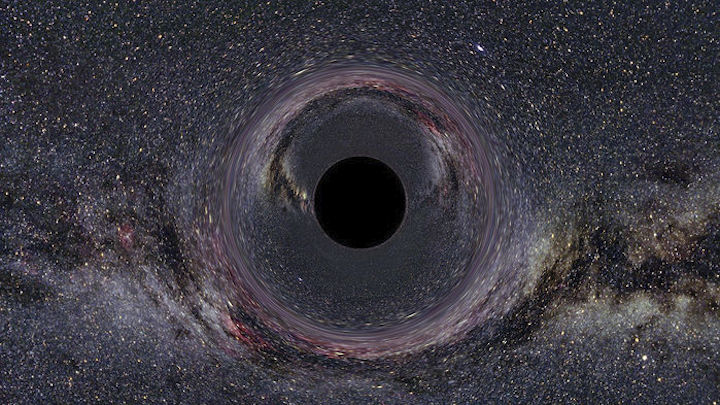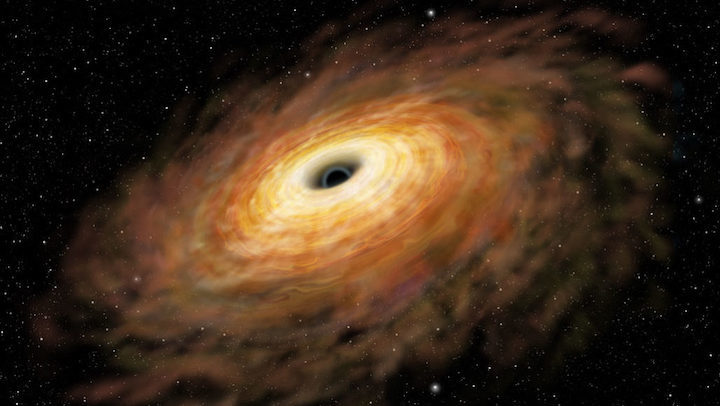28.11.2019

A Chinese-led research team has discovered a surprisingly huge stellar black hole about 14,000 light-years from Earth -- our "backyard" of the universe -- forcing scientists to re-examine how such black holes form.
The Milky Way galaxy is estimated to contain 100 million stellar black holes -- cosmic bodies formed by the collapse of massive stars and so dense even light can't escape. Until now, scientists had estimated the mass of an individual stellar black hole in our galaxy at no more than 20 times that of the Sun.
But the new discovery has toppled that assumption.
The team, headed by Liu Jifeng, of the National Astronomical Observatory of the Chinese Academy of Sciences (NAOC), spotted the black hole, which has a mass 70 times greater than the Sun. Researchers named the monster black hole LB-1.
The discovery was a big surprise. "Black holes of such mass should not even exist in our galaxy, according to most of the current models of stellar evolution," said Liu.
"We thought that very massive stars with the chemical composition typical of our galaxy must shed most of their gas in powerful stellar winds, as they approach the end of their life. Therefore, they should not leave behind such a massive remnant. LB-1 is twice as massive as what we thought possible. Now theorists will have to take up the challenge of explaining its formation."
Until a few years ago, stellar black holes could only be discovered when they gobbled up gas from a companion star. This process creates powerful X-ray emissions, detectable from Earth, which reveal the presence of the collapsed object.
The vast majority of stellar black holes in our galaxy are not engaged in a cosmic banquet though, and thus don't emit revealing X-rays. As a result, only about 20 galactic stellar black holes have been accurately identified and measured.
To counter this limitation, Liu and his team surveyed the sky with China's Large Sky Area Multi-Object Fiber Spectroscopic Telescope (LAMOST), looking for stars that orbit an invisible object, pulled by its gravity.
This observational technique was first proposed by the visionary English scientist John Michell in 1783, but it has only become feasible with recent technological improvements in telescopes and detectors.
Still, such a search is like looking for a needle in a haystack: only one star in a thousand might be circling a black hole.
After the initial discovery, the world's largest optical telescopes -- Spain's 10.4-m Gran Telescopio Canarias and the 10-m Keck I telescope in the United States -- were used to determine the system's physical parameters. The results were fantastic: a star eight times heavier than the Sun was seen orbiting a 70-solar-mass black hole every 79 days.
The discovery is reported in the latest issue of the academic journal Nature.
Quelle: Xinhua
+++
A newfound black hole in the Milky Way is weirdly heavy
The object is locked in orbit with a star about 13,800 light-years away from Earth

A heavyweight black hole in our galaxy has some explaining to do.
With a mass of about 68 suns, it is far heftier than other stellar-mass black holes (those with masses below about 100 suns) in and around the Milky Way, scientists say. That’s not just a record, it’s also a conundrum. According to theory, black holes in our galaxy that form from the explosive deaths of massive stars — as this one likely did — shouldn’t be heavier than about 25 suns.
The black hole is locked in orbit with a young blue star dubbed LB-1, which sits about 13,800 light-years away in the constellation Gemini, researchers found. Combing through data from the LAMOST telescope in China, Jifeng Liu, an astrophysicist at the Chinese Academy of Sciences in Beijing, and colleagues noticed that LB-1 repeatedly moves toward and away from Earth with great speed — a sign that the star orbits something massive.
With additional observations from telescopes in Hawaii and the Canary Islands, the team mapped out the orbit and deduced that the star gets whipped around by a dark mass roughly 68 times as massive as the sun. Only a black hole fits that description, the team reports November 27 in Nature.
“I never thought in my wildest dreams you could form a black hole this big [in the Milky Way],” says Michael Zevin, an astrophysicist at Northwestern University in Evanston, Ill. “If the observations pan out to be correct, this is really going to have people scratching their heads.”
This black hole is not the heftiest in the Milky Way. That title goes to the behemoth in the center of the galaxy, a supermassive black hole in a class all its own with a mass of over 4 million suns. The mass of LB-1’s black hole is, however, on par with some of the black holes discovered recently by gravitational wave detectors, which sense ripples in spacetime from (among other things) merging pairs of black holes (SN: 2/17/16).
But those black holes formed in far-off galaxies, probably in environments with a relative dearth of elements heavier than helium. The star LB-1 has a richer inventory of those elements, and presumably the star that formed its partner black hole had a similar stock. Stars with a greater abundance of heavy elements lose more of their mass to stellar winds, as those elements present a larger target to the radiation that drives those winds. Massive stars that form black holes also eject a lot of their mass during the supernova explosions that end their lives.
“These two processes make very small black holes even out of very massive stars,” Liu says. But the black hole near LB-1 apparently didn’t get that memo.
To make a black hole of 68 solar masses requires a reduction in the mass lost to stellar winds by a factor of five, Liu says. “We don’t know whether this is possible theoretically.”
Alternatively, the black hole might have emerged from a failed supernova, an attempted stellar explosion that doesn’t have quite enough energy to hurl the star’s guts into space, leaving the gas to fall back into the black hole.
The team also wonders if the black hole is the work of two stars. The scenario is speculative, Liu says, and “the odds are slim.” But in this story, LB-1 once orbited a snuggled-up pair of heftier stars that died and left behind two cores that merged into one black hole.
It’s also possible that what appears to be a single 68-solar-mass black hole is actually two lighter black holes locked in a tight embrace. Such a pair would periodically nudge LB-1, giving it a subtle rocking motion that Liu and colleagues are searching for with other telescopes.
Before getting caught up in potential origin stories, the observations need to be double-checked, Zevin cautions. “I wouldn’t put money down that it’s a definitive detection yet,” he says.
The one catch, which the researchers do note, is that the calculated mass of the black hole depends on getting the distance to LB-1 correct. Their derived distance of 13,800 light-years — based on the star’s apparent brightness and calculations of its intrinsic luminosity — is about twice as far as the distance to the star determined by the Gaia satellite, a multiyear mission to create a precise 3-D map of over 1 billion stars in the Milky Way (SN: 5/9/18). If the Gaia distance is correct, then the black hole might be only 10 times as massive as the sun. (If the star is closer, then it’s less luminous, so less massive. That would mean that a lighter black hole is needed to explain the speed at which the star is getting whipped around.)
That’s not necessarily a strike against the study. The researchers note that a much lower luminosity for the star would be at odds with its measured temperature. And if LB-1 is wobbling around a black hole, that would throw off the accuracy of the Gaia data, says Zevin. “But it is an important point that needs to be worked out.”
